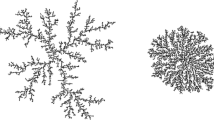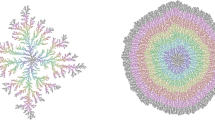Abstract
A recently proposed theory for diffusion-limited aggregation (DLA), which models this system as a random branched growth process, is reviewed. Like DLA, this process is stochastic, and ensemble averaging is needed in order to define multifractal dimensions. In an earlier work by Halsey and Leibig, annealed average dimensions were computed for this model. In this paper, we compute the quenched average dimensions, which are expected to apply to typical members of the ensemble. We develop a perturbative expansion for the average of the logarithm of the multifractal partition function; the leading and subleading divergent terms in this expansion are then resummed to all orders. The result is that in the limit where the number of particlesn→∞, the quenched and annealed dimensions areidentical; however, the attainment of this limit requires enormous values ofn. At smaller, more realistic values ofn, the apparent quenched dimensions differ from the annealed dimensions. We interpret these results to mean that while multifractality as an ensemble property of random branched growth (and hence of DLA) is quite robust, it subtly fails for typical members of the ensemble.
Similar content being viewed by others
References
T. A. Witten, Jr., and L. M. Sander,Phys. Rev. Lett. 47:1400 (1981).
P. Meakin,Phys. Rev. A 27:1495 (1983).
P. Meakin, InPhase Transitions and Critical Phenomena, Vol. 12, C. Domb and J. Lebowitz, eds. (Academic Press, New York, 1988).
T. Vicsek,Fractal Growth Phenomena (World Scientific, Singapore, 1989).
H. Gould, F. Family, and H. E. Stanley,Phys. Rev. Lett. 50:686 (1983); T. Nagatani,Phys. Rev. A 36:5812 (1987);J. Phys. A 20:L381 (1987); P. Barker and R. C. Ball,Phys. Rev. A 42:6289 (1990).
X. R. Wang, Y. Shapir, and M. Rubinstein,Phys. Rev. A 39:5974 (1989);J. Phys. A 22:L507 (1989).
L. Pietronero, A. Erzan, and C. J. G. Evertsz,Phys. Rev. Lett. 61:861 (1988);Physica A 151:207 (1988).
P. Meakin, H. E. Stanley, A. Coniglio, and T. A. Witten, Jr.,Phys. Rev. A 32:2364 (1985); C. Amitrano, A. Coniglio, and F. di Liberto,Phys. Rev. Lett. 57:1016 (1986); C. Amitrano,Phys. Rev. A 39:6618 (1989).
T. C. Halsey, P. Meakin, and I. Procaccia,Phys. Rev. Lett. 56:854 (1986); T. C. Halsey,Phys. Rev. Lett. 59:2067 (1987);Phys. Rev. A 38:4749 (1988).
Y. Hayakawa, S. Sato, and M. Matsushita,Phys. Rev. A 36:1963 (1987); R. C. Ball and O. Rath Spivack,J. Phys. A 23:5295 (1990).
T. C. Halsey and M. Leibig,Phys. Rev. A 46:7792 (1992).
T. C. Halsey,Phys. Rev. Lett. 72:1228 (1994).
R. Blumenfeld and A. Aharony,Phys. Rev. Lett. 62:2977 (1989); R. C. Ball and R. Blumenfeld,Phys. Rev. A 44:828 (1991); S. Schwarzer, J. Lee, A. Bunde, S. Havlin, H. E. Roman, and H. E. Stanley,65:603 (1990); B. Mandelbrot and C. J. G. Evertsz,Nature 348:143 (1990); S. Schwarzer, J. Lee, S. Havlin, H. E. Stanley, and P. Meakin,Phys. Rev. A 43:1134 (1991).
B. B. Mandelbrot, H. Kaufman, A. Vespinani, I. Yekutieli, and C. H. Lam,Europhys. Lett. 29:599 (1995).
P. Ossadnik,Physica A 195:319 (1993).
M. Muthukumar,Phys. Rev. Lett. 50:839 (1983); S. Tolman and P. Meakin,Phys. Rev. A 40:428 (1989).
R. Brady and R. C. Ball,Nature 309:225 (1984); J. Nittmann, G. D'accord, and H. E. Stanley,Nature 314:141 (1985); D. Kessler, J. Koplik, and H. Levine,Adv. Phys. 37:255 (1988).
P. Meakin,Phys. Rev. Lett. 51:1119 (1983); M. Kolb, R. Botet, and R. Jullien,Phys. Rev. Lett. 51:1123 (1983); P. Meakin, G. Li, L. M. Sander, H. Yan, F. Guinea, O. Pla, and E. Louis, inDisorder and Fracture, J. C. Charmet, S. Roux, and E. Guyon, eds. (Plenum Press, New York, 1990).
A. Renyi,Probability Theory (North-Holland, Amsterdam, 1970); B. B. Mandelbrot,Ann. Isr. Phys. Soc. 225 (1977); H. G. E. Hentschel and I. Procaccia,Physica 8D:435 (1983); U. Frisch and G. Parisi, inTurbulence and Predictability in Geophysical Fluid Dynamics and Climate Dynamics, M. Ghil, R. Benzi, and G. Parisi, eds. (North-Holland, Amsterdam, 1985), p. 84.
T. C. Halsey, M. H. Jensen, L. P. Kadanoff, I. Procaccia, and B. Shraiman,Phys. Rev. A 33:1141 (1986).
M. E. Cates and T. A. Witten,Phys. Rev. A 35:1809 (1987); T. C. Halsey, InFractals: Physical Origin and Properties, L. Pietronero, ed. (Plenum Press, New York, 1989).
S. Redner,Am. J. Phys. 58:267 (1990).
B. B. Mandelbrot, InFractals: Physical Origin and Properties, L. Pietronero, ed. (Plenum Press, New York, 1989); A. B. Chhabra and K. R. Sreenivasan,Phys. Rev. A 43:1114 (1991).
T. C. Halsey, K. Honda, and B. Duplantier, Unpublished.
Author information
Authors and Affiliations
Rights and permissions
About this article
Cite this article
Halsey, T.C., Honda, K. & Duplantier, B. Multifractal dimensions for branched growth. J Stat Phys 85, 681–743 (1996). https://doi.org/10.1007/BF02199360
Received:
Issue Date:
DOI: https://doi.org/10.1007/BF02199360




